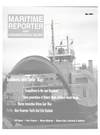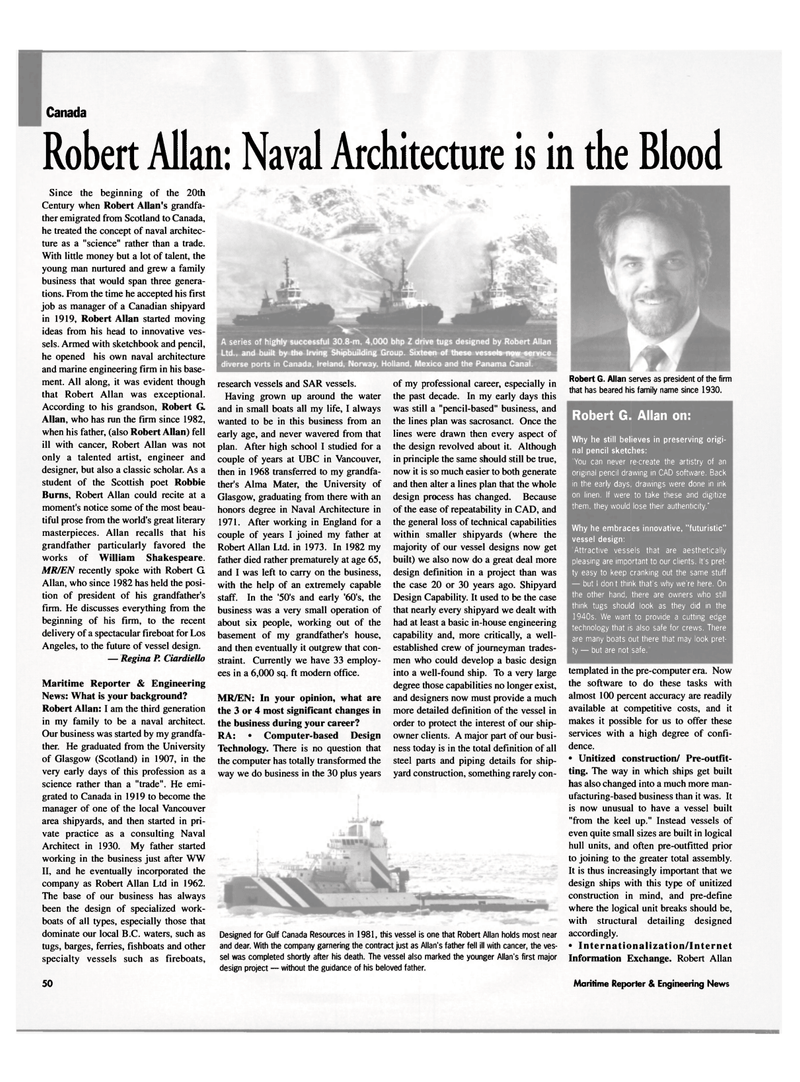
Page 50: of Maritime Reporter Magazine (May 2003)
Read this page in Pdf, Flash or Html5 edition of May 2003 Maritime Reporter Magazine
Canada
Robert Allan: Naval Architecture is in the Blood
Since the beginning of the 20th
Century when Robert Allan's grandfa- ther emigrated from Scotland to Canada, he treated the concept of naval architec- ture as a "science" rather than a trade.
With little money but a lot of talent, the young man nurtured and grew a family business that would span three genera- tions. From the time he accepted his first job as manager of a Canadian shipyard in 1919, Robert Allan started moving ideas from his head to innovative ves- sels. Armed with sketchbook and pencil, he opened his own naval architecture and marine engineering firm in his base- ment. All along, it was evident though that Robert Allan was exceptional.
According to his grandson, Robert G.
Allan, who has run the firm since 1982, when his father, (also Robert Allan) fell ill with cancer, Robert Allan was not only a talented artist, engineer and designer, but also a classic scholar. As a student of the Scottish poet Robbie
Burns, Robert Allan could recite at a moment's notice some of the most beau- tiful prose from the world's great literary masterpieces. Allan recalls that his grandfather particularly favored the works of William Shakespeare.
MR/EN recently spoke with Robert G
Allan, who since 1982 has held the posi- tion of president of his grandfather's firm. He discusses everything from the beginning of his firm, to the recent delivery of a spectacular fireboat for Los
Angeles, to the future of vessel design. — Regina P. Ciardiello
Maritime Reporter & Engineering
News: What is your background?
Robert Allan: I am the third generation in my family to be a naval architect.
Our business was started by my grandfa- ther. He graduated from the University of Glasgow (Scotland) in 1907, in the very early days of this profession as a science rather than a "trade". He emi- grated to Canada in 1919 to become the manager of one of the local Vancouver area shipyards, and then started in pri- vate practice as a consulting Naval
Architect in 1930. My father started working in the business just after WW
II, and he eventually incorporated the company as Robert Allan Ltd in 1962.
The base of our business has always been the design of specialized work- boats of all types, especially those that dominate our local B.C. waters, such as tugs, barges, ferries, fishboats and other specialty vessels such as fireboats, research vessels and SAR vessels.
Having grown up around the water and in small boats all my life, I always wanted to be in this business from an early age, and never wavered from that plan. After high school I studied for a couple of years at UBC in Vancouver, then in 1968 transferred to my grandfa- ther's Alma Mater, the University of
Glasgow, graduating from there with an honors degree in Naval Architecture in 1971. After working in England for a couple of years I joined my father at
Robert Allan Ltd. in 1973. In 1982 my father died rather prematurely at age 65, and I was left to carry on the business, with the help of an extremely capable staff. In the '50's and early '60's, the business was a very small operation of about six people, working out of the basement of my grandfather's house, and then eventually it outgrew that con- straint. Currently we have 33 employ- ees in a 6,000 sq. ft modern office.
MR/EN: In your opinion, what are the 3 or 4 most significant changes in the business during your career?
RA: • Computer-based Design
Technology. There is no question that the computer has totally transformed the way we do business in the 30 plus years of my professional career, especially in the past decade. In my early days this was still a "pencil-based" business, and the lines plan was sacrosanct. Once the lines were drawn then every aspect of the design revolved about it. Although in principle the same should still be true, now it is so much easier to both generate and then alter a lines plan that the whole design process has changed. Because of the ease of repeatability in CAD, and the general loss of technical capabilities within smaller shipyards (where the majority of our vessel designs now get built) we also now do a great deal more design definition in a project than was the case 20 or 30 years ago. Shipyard
Design Capability. It used to be the case that nearly every shipyard we dealt with had at least a basic in-house engineering capability and, more critically, a well- established crew of journeyman trades- men who could develop a basic design into a well-found ship. To a very large degree those capabilities no longer exist, and designers now must provide a much more detailed definition of the vessel in order to protect the interest of our ship- owner clients. A major part of our busi- ness today is in the total definition of all steel parts and piping details for ship- yard construction, something rarely con-
Designed for Gulf Canada Resources in 1981, this vessel is one that Robert Allan holds most near and dear. With the company garnering the contract just as Allan's father fell ill with cancer, the ves- sel was completed shortly after his death. The vessel also marked the younger Allan's first major design project — without the guidance of his beloved father.
Robert G. Allan serves as president of the firm that has beared his family name since 1930.
Robert G. Allan on:
Why he still believes in preserving origi- nal pencil sketches: "You can never re-create the artistry of an original pencil drawing in CAD software. Back in the early days, drawings were done in ink on linen. If were to take these and digitize them, they would lose their authenticity."
Why he embraces innovative, "futuristic" vessel design:
Attractive vessels that are aesthetically pleasing are important to our clients. It's pret- ty easy to keep cranking out the same stuff — but I don't think that's why we're here. On the other hand, there are owners who still think tugs should look as they did in the 1940s. We want to provide a cutting edge technology that is also safe for crews. There are many boats out there that may look pret- ty — but are not safe." templated in the pre-computer era. Now the software to do these tasks with almost 100 percent accuracy are readily available at competitive costs, and it makes it possible for us to offer these services with a high degree of confi- dence. • Unitized construction/ Pre-outfit- ting. The way in which ships get built has also changed into a much more man- ufacturing-based business than it was. It is now unusual to have a vessel built "from the keel up." Instead vessels of even quite small sizes are built in logical hull units, and often pre-outfitted prior to joining to the greater total assembly.
It is thus increasingly important that we design ships with this type of unitized construction in mind, and pre-define where the logical unit breaks should be, with structural detailing designed accordingly. • Internationalization/Internet
Information Exchange. Robert Allan 50 Maritime Reporter & Engineering News

 49
49

 51
51
